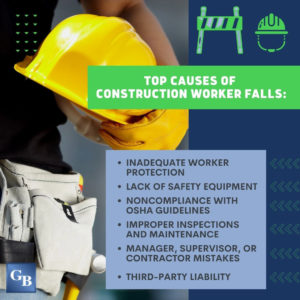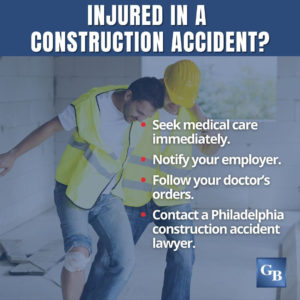Construction Falls
Falls are the leading cause of accidents on construction sites. More than one in three construction worker fatalities occur due to falling. Laborers who work 6 or more feet above ground are at risk for severe injury or death if they fall.
The following are common causes of fall-related construction injuries or death.
Inadequate Fall Protection
OSHA requires employers to protect their workers at a construction site adequately. Construction sites require protective equipment and devices at 6-feet or higher elevations.
Common construction fall protection includes:
- Harnesses, also known as personal fall arrest systems.
- Guardrails, required on scaffolding, scissor lifts, and other enclosed platforms.
- Safety nets, designed to deflect and absorb the energy of a fall to reduce the likelihood of injury.
These safety devices must also meet strict OSHA regulations. For example, guardrails must be a minimum of 42 inches. Many accidents are a result of noncompliance with OSHA standards, such as lack of guardrails, missing harnesses, and no safety nets.
Many construction site falls also occur due to a lack of or defective protective equipment, including:
- Malfunctioning buckles on harnesses.
- Loose or faulty hooks or other harness parts.
- Worn harness straps.
Falls can also happen due to errors that render protective devices ineffective, such as:
- Falls from scaffolding due to improperly installed guardrails.
- Improper rigging and placement of safety nets.
- Scaffolding collapse.
Employers who fail to protect workers from falls may be liable for injuries and deaths on a construction site. Third parties may also be found negligent.
Falls From Roofs
OSHA reports that falls from roofs account for one-third of fatal falls among construction workers. Roofs under construction are particularly dangerous due to:
- Unguarded edges: Falls through openings, such as unfinished portions of the roof and skylights that do not have guardrails around them.
- Falls along the part of the roof under construction: Many falls also occur because a worker lacks protective gear or a supervisor, safety manager, or contractor made mistakes in directing work or securing protective equipment.
Falls From Scaffolding
OSHA reports that nearly two out of three construction workers frequently perform at least part of their work on scaffolding, and almost 4,500 workers are injured each year in scaffold-related incidents.
Common scaffold hazards include:
- Lack of proper guardrails, mid-rails, and toeboards on all open sides of the scaffold.
- Scaffold collapse caused by improper construction, defective equipment, or exceeded load capacity.
- Active electrical lines which could be contacted by other building materials or equipment.
- Untrained workers.
- Weather incidents that render a scaffold unsafe but an employer does not stop work.
Falls From Ladders
Ladders are not safer than other lifting equipment simply because they are closer to the ground. They can still cause traumatic injuries.
Supervisors and safety managers should train employees not to trust their weight on a ladder without inspecting it for defects. OSHA requires defective ladders to be taken out of service. Other OSHA ladder safety guidelines include:
- Ladders must support at least four times the maximum intended load.
- Do not use a stepladder as a straight ladder; always use the right ladder for the job.
- Do not lean while on a ladder; move the ladder over if something is out of reach.
Other causes of ladder falls include lack of inspection and maintenance, allowing defective, broken, or worn ladders to be used on the job site, and rungs that break while a worker is on the ladder.
Falls From Aerial Lifts
Aerial lifts are standard equipment at construction sites because they work well in lifting people and equipment when properly operated. Unfortunately, untrained workers may be operating the lifts, causing workers to fall from the bucket or platform.
In addition, many aerial lifts are set up on uneven ground, making the lift sway, tilt, or tip, potentially causing unsecured workers to be thrown to the ground. Mechanical failures can injure or kill workers as well.
Slips, Trips, and Falls
Construction site surfaces quickly become crowded with workers, tools, and materials. When workers have limited room and many hazards in the way, the likelihood of a fall increases. Even a mistake such as leaving a tool on a platform where another worker would not expect it can cause a fall.
Other common hazards include:
- Environmental factors such as rain, ice, snow, or mud that could cause slipping.
- Waste and debris scattered around the worksite, such as tools, building materials, power cords, sawdust, grease, paint, and remnants from wood, cement, metal, or rebar.
- Surface defects such as potholes, uneven sidewalks, temporary walkways, or ruts leftover from the wheels of heavy machinery.
- Scaffolding, lifts, and other defective or unmaintained equipment. For example, a loose board or raised nail can quickly become a fall hazard.
Lack of Training
An employer or its subcontractor must ensure that employees are trained in how to do their jobs and practice safety. They must do this training in the language that workers understand. Too often, a manager or subcontractor will hurry through training or not ensure that workers know about hazards they may encounter.
Lack of Protective Equipment or Devices
Some employers or contractors simply do not budget for or provide safety equipment, such as personal protection equipment and jobsite safeguards. They may be trying to save money or complete a job more quickly. Some may have protections but not up to OSHA guidelines. OSHA standards exist to be followed.
Other Causes of Construction Falls
Any number of construction site conditions can cause accidents. Other causes include:
- Unprotected or unmarked ledges.
- Wall openings.
- Floor holes.
- Inclement weather that causes roofers and other workers to fall.
- Lack of handrails or stair rails.
- Unguarded elevator shafts.
- Unmarked trenches and excavation sites.
 Google Screened
Google Screened


 Notify Supervisors
Notify Supervisors